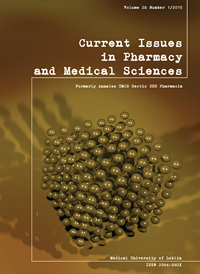The influence of an opioid on the course of reparative processes
DOI:
https://doi.org/10.1515/cipms-2015-0042Keywords:
skin, animal model, reparative process, opioidAbstract
The objective of our work is to examine the influence of prolonged administration of an opioid, on the course of the reparative process of a multiple post-injection wound inflicted upon a white rat’s skin, doing so by way of using light microscopy. The studies were carried out on 24 mature white male rats, aged 4.5-7.5 months, with weights of 130-150 g. For histological examination, the skin sections were stained with hematoxylin and eosin. The preparations were studied and photographed at the magnification of ob.х8, ey.x15 and ob.x40, ey.x10. The «Aver Media» computer system was employed for micropreparations photography. The set levels of light microscopy reveal that the administration of an opioid for a 2 week period does not affect the reparative process of a multiple post-injection wound. Moreover, in most wound canals, the formation of a complete regenerate can be seen. However, after 4 weeks of nalbufin administration, the processes of wound healing slowed and were complicated by the formation of microabscesses. After 6 weeks of opioid administration, destructive changes in the skin were detected. These, in turn, led to the incomplete regenerate formation in the multiple postinjection wound. The experimental results, hence, show the negative effect of prolonged administration of opioid on the reparative processes in the skin.
References
1. Akhavani M.A. et al.: Angiogenesis and plastic surgery. Plast. Rec. Surg., 86(12), 1425, 2008.
2. Assadian Q., Assadian A., Senekowitsch C.: Gas gangrene due to Clostridium perfringens in two injecting drug users in Vienna, Austria. Wien. Klin. Wschr., 116(7-8), 264, 2004.
3. Brown P.D., Ebright J.R.: Skin and soft tissue infections in injection drug users. Curr. Infect. Dis. Rep., 4(5), 415, 2002. [CrossRef]
4. Criado P.R., Maruta C.W.: Histamine, histamine receptors and antihistamines: new concepts. An. Bras. Dermatol., 85(2), 195, 2010. [Web of Science] [CrossRef]
5. Currie B.J., Group.: A streptococcal infections of the skin: Molecular advances but limited therapeutic progress. Curr. Opin. Infect. Dis., 19, 132, 2006. [CrossRef]
6. Dakal A.: Clinical signs of odontogenous suppirative and inflammatory diseases of maxillofacial are in drug-addicted patient, 7th Congress of Baltic Association for Maxillofacial and Plastic Surgery, May 20-22, 71, 2010.
7. Datsenko B.M., Kutepova N.V., Borisenko V.B.: Transformation of collagens in infected wound with allotransplants. Clinical Surgery, 11, 16, 2011. (in Russian).
8. Friedman H., Pross S., Klein T.W.: Addictive drugs and their relationship with infectious diseases. FEMS Immunol. Med. Microbiol., 47(3), 330, 2006.
9. Gerych I.D. et al.: Liquid volumetric vulnerometry and criteria of vulnerometrical estimations of the wounds. Bulletin of the Ukrainian Medical Dental Academy, 9(1), 276, 2009.
10. Lipschitz G.V. Zvyahyntseva T.: Cell-cell interactions in the wound process. International Journal of Medical Scienses, 5(4), 120, 1999. (in Russian).
11. Onisko R.M. et al.: A method of modeling physical opioid dependence in rats, Patent: Danylo Halytsky Lviv National Medical University, Ukraine, u201207124; appl. 12.06.2012; publ. 10.01.2013, Bulletin number 1. (in Ukrainian).
12. Ozawa C.R. et al.: Microenvironmental VEGF concentration, not total dose, determines a threshold between normal and aber rant angiogenesis. J. Clin. Invest., 113(4), 516, 2004.
13. Pasichnyi D.A.: Macrovascular changes in skin wound in response to wound dermotension and cryotherapy. International Journal of Medical Scienses, 15(2), 68, 2009. (in Russian).
14. Sarkisov D.S. et al. (1990). Morphology of wound healing process. Medicine, Moscow; p.38-89. (in Russian).
15. Shestakova I.V., Yushchuk N.D., Tyshkevych O.L.: Myonecrosis in injecting drug users (clinical observation). Therapeutic Archives, 82(11), 37, 2010. (in Russian).
16. Theoharides C.T., Singh K.L., Boucher W.: Cor ticotropin-releasing hormone induces skin mast cell degranulation and increased vascular permeability, a possible explanation for its proinflammatory effects. Endocrinology, 139(1), 403, 2005.
17. Tymofiev A.A., Dakal A.V.: The use of modern drugs for the local treatment of purulent wounds in drug addicted patients with odontogenic abscesses. Modern dentistry, 4(44), 95, 2008. (in Russian).
18. Weller K. et al.: Mast cells are required for normal healing of skin wounds in mice. The FASEB Journal, E1, 2006.
Downloads
Published
Issue
Section
License
Copyright (c) 2015 Authors

This work is licensed under a Creative Commons Attribution-NonCommercial-NoDerivatives 3.0 Unported License.


